This
page is on the internet at http://www.mmdtkw.org/GR-Unit9-PoleisDevelopmentColonization.html

Unit
9: Poleis development, colonization
Polis
Polis (;
Greek: πόλις [pólis]), plural poleis
(,
πόλεις [póleːs])
literally means city
in Greek. It can also mean citizenship and body of
citizens. In modern historiography, polis is
normally used to indicate the ancient Greek
city-states, like Classical Athens and its
contemporaries, and thus is often translated as "city-state".
The Ancient Greek city-state
developed during the Archaic
period as the ancestor of city, state, and citizenship and
persisted (though with decreasing influence) well into Roman times, when the equivalent
Latin
word was civitas, also meaning "citizenhood", while
municipium applied to a non-sovereign local
entity. The term "city-state", which originated in
English (alongside the German Stadtstaat), does not
fully translate the Greek term. The poleis
were not like other primordial ancient city-states like Tyre or Sidon,
which were ruled by a king or a small oligarchy, but rather political
entities ruled by their bodies of citizens.
The traditional view of archaeologists—that the appearance
of urbanization at excavation sites
could be read as a sufficient index for the development of a
polis—was criticised by François Polignac in 1984
and has not been taken for granted in recent decades: the polis
of Sparta, for example, was established in a network of
villages. The term polis, which in archaic
Greece meant "city", changed with the development of the
governance center in the city to signify "state" (which
included its surrounding villages). Finally, with the
emergence of a notion of citizenship among landowners, it
came to describe the entire body of citizens. The
ancient Greeks did not always refer to Athens,
Sparta, Thebes, and other poleis
as such; they often spoke instead of the Athenians,
Lacedaemonians, Thebans and so on. The body of citizens came
to be the most important meaning of the term polis
in ancient Greece.
The Greek term that specifically
meant the totality of urban buildings and spaces is
ἄστυ (pronounced [ásty]).
The Emergence of the Greek Polis
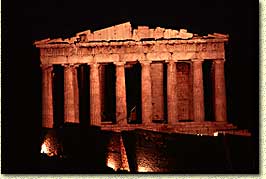 There is a great deal of
controversy surrounding the question of why Greek
communities became poleis. Some historians and political
analysts found it inevitable. Aristotle, in fact, claimed
that the polis was the natural situation for mankind. He
defined humans as "beings who by nature live in a polis" (Politics
1253a2-3). However, the polis was a unique Greek invention
and far from inevitable. The specific geography and history
of Greece allowed its conception.
There is a great deal of
controversy surrounding the question of why Greek
communities became poleis. Some historians and political
analysts found it inevitable. Aristotle, in fact, claimed
that the polis was the natural situation for mankind. He
defined humans as "beings who by nature live in a polis" (Politics
1253a2-3). However, the polis was a unique Greek invention
and far from inevitable. The specific geography and history
of Greece allowed its conception.
The polis consisted of the city and its surrounding lands
and communities. The whole area was an individual unit with
self-rule. Unlike the Mycenaean cities of Greek's past,
where the powerless poor answered to the powerful
aristocracy and the godlike king, every citizen was at least
equal under the law. Citizenship was limited to natives, and
only male adult citizens could exercise the vote, but power
was distributed more widely than in any previous political
system.
The polis was most efficient if it was small, since large
groups were hard to coordinate as a decision-making body.
Greek political theorists judged that 5 to 10,000 citizens
was the ideal size of a Greek polis. In such a sized
community, most citizens could at least recognize by face
most other citizens.
Greek geography helped keep communities small. Covered with
mountains and inlets, it provided many natural barriers that
isolated neighboring communities. This isolation both
limited the size of most poleis and made large-scale empire
difficult, so most communities could control their own
destiny.
The fall of Mycenaean power and Greece's dark age also
provided a nurturing environment for developing poleis. The
sudden disappearance of political structure provided a
vacuum of power that was filled by the leaders of local
communities. Each city became master of its own destiny.
Over the course of the Dark Age, kingship vanished, and
power was deposited in the hands of the nobles. As the
fighting power of the Greek hoplite grew, rich men without
distinguished lineage could claim importance in the defence
of their community, and power began to be spread even
further. As the aristocracy declined in power, the formerly
powerless took part in government.
Since so much of the early development of the polis is lost
to history, much of the above is speculation. Still, it is
clear that the absence of central authority, paired with the
individualistic nature of Greek communities, led to the
emergence of the polis.
------------------------------------------------------------
Early Colonization
From http://www.perseus.tufts.edu/hopper/text?doc=Perseus%3Atext%3A1999.04.0009%3Achapter%3D5
Some Greeks had emigrated from the mainland eastward
across the Aegean Sea to settle in Ionia
as early as the ninth century BC. Starting around
750 BC, however, Greeks began to settle even farther
outside the Greek homeland. Within two hundred years,
Greek colonies were established in areas that are today
southern France, Spain, Sicily and southern Italy, and
along North Africa and the coast of the Black Sea.
Eventually the Greek world had perhaps as many as 1,500
different city-states. A scarcity of arable land
certainly gave momentum to emigration from Greece, but
the revival of international trade in
the Mediterranean in this era perhaps provided the
original stimulus for Greeks to leave their homeland,
whose economy was still struggling. Some Greeks
with commercial interests took up residence in foreign
settlements, such as those founded in Spain in this
period by the Phoenicians from Palestine. ...
Like other peoples of
the eastern Mediterranean, Greeks also established their
own trading posts abroad. Traders from Euboea, for
instance, had already established commercial contacts by
800 BC with a community located on the Syrian coast at a
site now called Al Mina. Men wealthy enough to
finance risky expeditions by sea ranged far from home in
search of metals. Homeric poetry testifies to the
basic strategy of this entrepreneurial commodity
trading. In the Odyssey , the goddess
Athena once appears disguised as a metal trader to hide
her identity from the son of the poem's hero: “I
am here at present,” she says to him, “with my ship
and crew on our way across the wine-dark sea to
foreign lands in search of copper; I am carrying iron
now.” By about 775 BC, Euboeans, who seem to
have been particularly active explorers, had also
established a settlement for purposes of trade on the
island of Ischia, in the bay of Naples off southern
Italy. There they processed iron ore imported from the
Etruscans, who lived in central Italy. Archaeologists
have documented the expanding overseas communication of
the eighth century by finding Greek pottery at more than
eighty sites outside the Greek homeland ....
---------------------------------------------------------
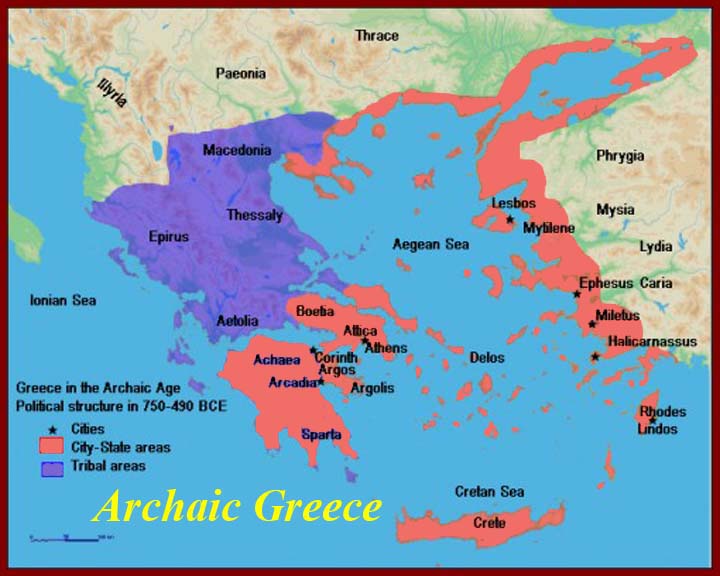
Parts of archaic Greece had the appearance of city
states already toward the end of the "Dark Age" and many
other parts rapidly joined the list. We
should remember that, in the Archaic Period, both coasts
of the Aegean Sea and the whole shoreline of the Sea of
Marmara were Greek. And During the Archaic Period,
colonies spread Greek presence much further. As
noted above, the Eubeans had established what is
considered to be the first Greek colony on Ischia Island
in the Bay of Naples.
Athens and Sparta -- two divergent
examples of polis development
Athens
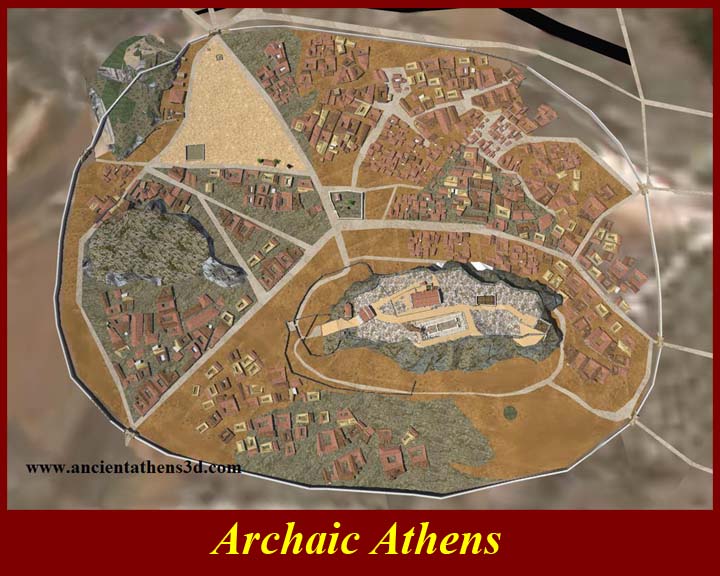
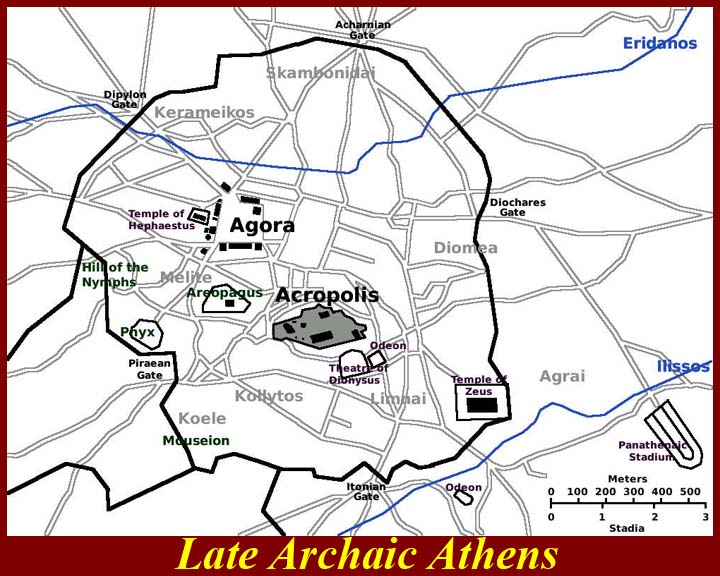
Drawings of overhead views of Archaic Athens.
Unlike many other Bronze Age sites, Athens was not
abandoned at the end of that period. It remained
an urban center throughout the Dark Age.
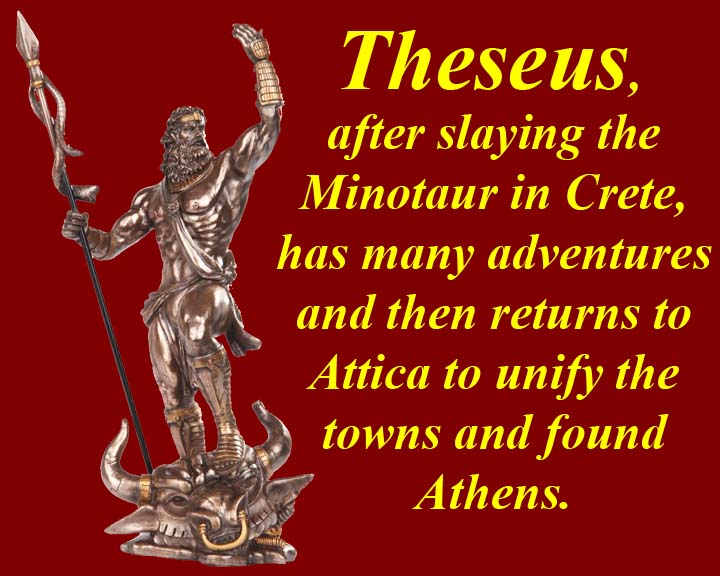
Every city needs a founding myth. Theseus (Ancient
Greek: Θησεύς) was the mythical founder-king of Athens
and was the son of Aethra by two fathers: Aegeus and
Poseidon (double paternity caused by consecutive coitus
was not uncommon in Greek mythology and is, in fact,
possible).
According to the myth, after slaying the Minotaur and
decapitating the beast, Theseus used the string given to
him by Ariadne, the daughter of the Cretan king, Minos,
to find his way out of the Labyrinth and managed to
escape with all of the young Athenians and with Ariadne
as well as her younger sister Phaedra. On the beach, he and the rest of the crew fell
asleep. Athena woke Theseus and told him to leave
early that morning. She told Theseus to leave
Ariadne and Phaedra on the beach. Stricken with
distress, Theseus forgot to put up the white sails
instead of the black ones, so Aegeus committed suicide,
in some versions throwing himself off a cliff and into
the sea, thus causing this body of water to be named the
Aegean. Theseus went on to gather the Attic
peoples and found a polis, which, under the protection
of Athena became Athens.
According to Plutarch's Life of Theseus, the ship
Theseus used on his return from Crete to Athens was kept
in the Athenian harbor as a memorial for several
centuries.
See https://en.wikipedia.org/wiki/Theseus
for more of the Theseus mythology.
There are all kinds of inconsistencies and anachronisms
in this Athens founding myth, but that also was not uncommon in such
stories.
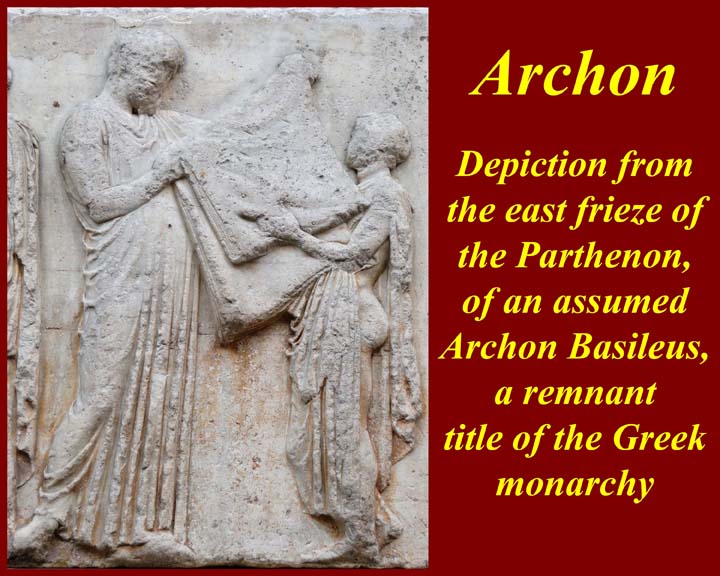
Archon (Greek ἄρχων arkhon; pl. ἄρχοντες) is a Greek
word that means "ruler" or "lord," frequently used as
the title of a specific public office. It is the
masculine present participle of the verb stem ἀρχ-,
meaning "to rule," derived from the same root as
monarch.
In ancient Greece the chief magistrate in various Greek
city states was called Archon. The term was also used
throughout Greek history in a more general sense.
In Athens a republican system of nine concurrent Archons
evolved, led by three respective remits over the civic,
military, and religious affairs of the state: the three
office holders being known as the Eponymos archon
(Ἐπώνυμος ἄρχων; the "name" ruler, who gave his name to
the year in which he held office), the Polemarch ("war
ruler"), and the Archon Basileus ("king ruler").[1] The
six others were the Thesmothétai, Judicial Officers.
Originally these offices were filled from the wealthier
classes by elections every ten years. During this period
the eponymous Archon was the chief magistrate, the
Polemarch was the head of the armed forces, and the
Archon Basileus was responsible for some civic religious
arrangements, and for the supervision of some major
trials in the law courts. After 683 BC the offices were
held for only a single year, and the year was named
after the Archōn Epōnymos. (Many ancient calendar
systems did not number their years consecutively.)
After 487 BC, the archonships were assigned by lot to
any citizen and the Polemarch's military duties were
taken over by new class of generals known as
stratēgoí.[citation needed] The ten stratēgoí (one per
tribe) were elected, and the office of Polemarch was
rotated among them on a daily basis. The Polemarch
thereafter had only minor religious duties, and the
titular headship over the strategoi. The Archon Eponymos
remained the titular head of state under democracy,
though of much reduced political importance.[citation
needed] The Archons were assisted by "junior" archons,
called Thesmothétai (Θεσμοθέται "Institutors"). After
457 BC ex-archons were automatically enrolled as life
members of the Areopagus, though that assembly was no
longer extremely important politically at that time.
See https://en.wikipedia.org/wiki/Archon
and links on that Internet page.
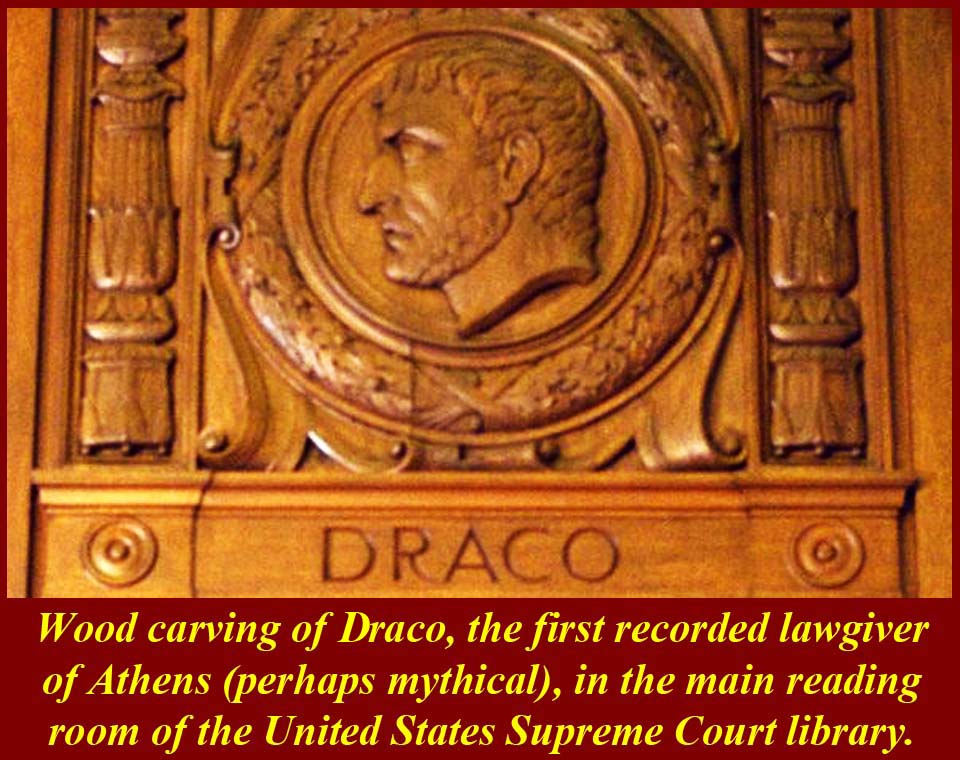
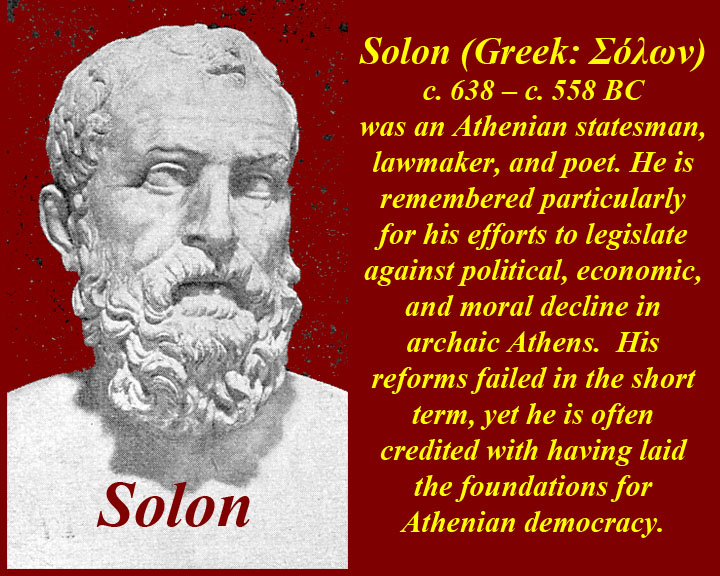
Athenian Law:
Draco /Greek: Δράκων, Drakōn; fl. c. 7th century BC) was
the first legislator of Athens in Ancient Greece.
During the 39th Olympiad, in 622 or 621 BC, Draco
established the legal code with which he is
identified. He replaced the prevailing system of
oral law and blood feud by a written code to be enforced
only by a court. His laws, however were
"Draconian", i.e., even minor offenses could bring the
death penalty. See https://en.wikipedia.org/wiki/Draco_(lawgiver).
Solon (Greek: Σόλων; c. 638 – c. 558 BC) was an Athenian
statesman, lawmaker, and poet. He is remembered
particularly for his efforts to legislate against
political, economic, and moral decline in archaic
Athens. His reforms failed in the short term, yet
he is often credited with having laid the foundations
for Athenian democracy. He wrote poetry for
pleasure, as patriotic propaganda, and in defense of his
constitutional reforms. See
https://en.wikipedia.org/wiki/Solon.
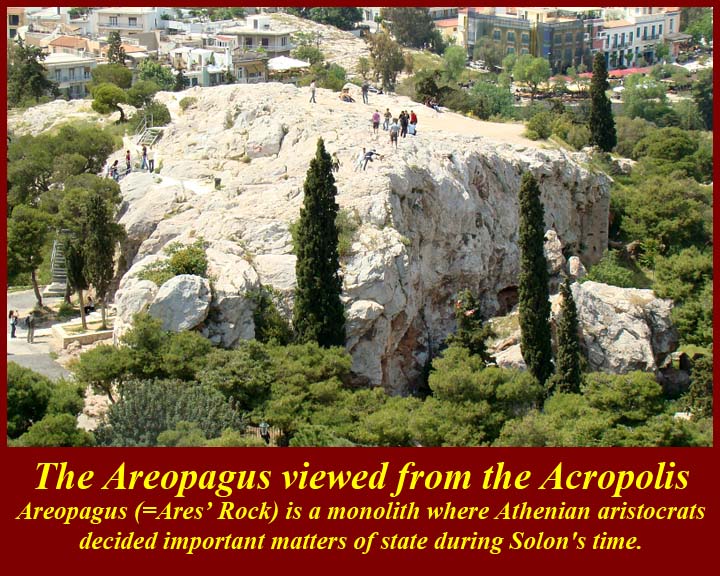
Areopagus -- Athenian Rock and Greek council
Written by: The Editors of Encyclopædia Britannica http://www.britannica.com/topic/Areopagus-Greek-council
Alternative titles: Areopagite Council; Council of the
Hill of Ares
Areopagus, earliest aristocratic council of
ancient Athens. The name was taken from the Areopagus
(“Ares’ Hill”), a low hill northwest of the Acropolis,
which was its meeting place. [tkw note: the low hill is
actually a marble outcrop as shown in the image.]
The Areopagite Council probably began as the king’s
advisers. Early in the Archaic period it exercised a
general and ill-defined authority until the publication
of Draco’s Code of Law (c. 621). Membership continued
for life and was secured by having served as archon, an
office limited to the eupatrids (Greek: eupatridai,
“nobles by birth”). Under Solon (archon 594 bc), the
composition and authority of the council were materially
altered when the archonship was opened to all with
certain property qualifications, and a Boule, a rival
council of 400, was set up. The Areopagus nevertheless
retained “guardianship of the laws” (perhaps a
legislative veto); it tried prosecutions under the law
of eisangelia (“impeachment”) for unconstitutional acts.
As a court under the presidency of the archōn basileus,
it also decided cases of murder.
For about 200 years, from the middle of the 6th century
bc, the prestige of the Areopagus fluctuated. The fall
of the Peisistratids, who during their tyranny (546–510)
had filled the archonships with their adherents, left
the Areopagus full of their nominees and thus in low
esteem; its reputation was restored by its patriotic
posture during the Persian invasion. In 462 the reformer
Ephialtes deprived the Areopagus of virtually all its
powers save jurisdiction on homicide (c. 462). From the
middle of the 4th century bc, its prestige revived once
again, and by the period of Roman domination in Greece
it was again discharging significant administrative,
religious, and educational functions.
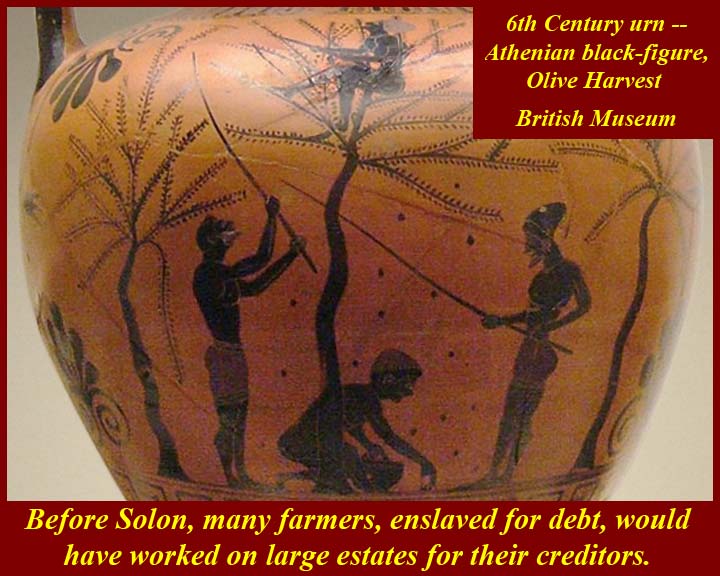
Solon's reforms did succeed in removing personal and
family member debt slavery, which had been a large
source of labor on creditors' farms.
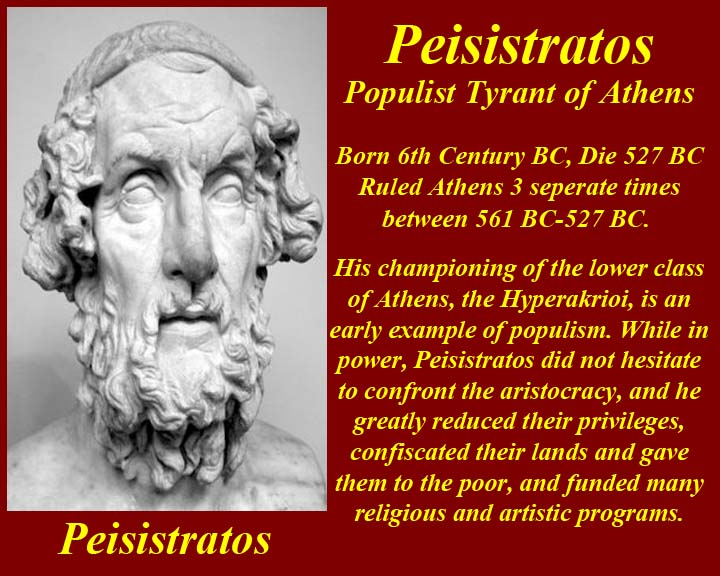
Peisistratos (/paɪˈsɪstrətəs/; Greek: Πεισίστρατος; died
528/7 BCE), latinized Pisistratus, the son of
Hippocrates, was a ruler of ancient Athens during most
of the period between 561 and 527 BCE. His legacy
lies primarily in his institution of the Panathenaic
Festival and the consequent first attempt at producing a
definitive version of the Homeric epics.
Peisistratos' championing of the lower class of Athens,
the Hyperakrioi, is an early example of populism.
While in power, Peisistratos did not hesitate to
confront the aristocracy, and he greatly reduced their
privileges, confiscated their lands and gave them to the
poor, and funded many religious and artistic programs.
Peisistratids is the common term for the three tyrants
who ruled in Athens from 546 to 510 BC, namely
Peisistratos and his two sons, Hipparchus and Hippias.
Pisistratus's main policies were aimed at strengthening
the economy, and similar to Solon, he was concerned
about both agriculture and commerce. He offered
land and loans to the needy. He encouraged the
cultivation of olives and the growth of Athenian trade,
finding a way to the Black Sea and even Italy and
France. Under Peisistratus, fine Attic pottery
traveled to Ionia, Cyprus, and Syria. In Athens,
Pisistratus' public building projects provided jobs to
people in need while simultaneously making the city a
cultural center. He replaced the private wells of
the aristocrats with public fountain houses.
Pisistratos also built the first aqueduct in Athens,
opening a reliable water supply to sustain the large
population.
See https://en.wikipedia.org/wiki/Peisistratos
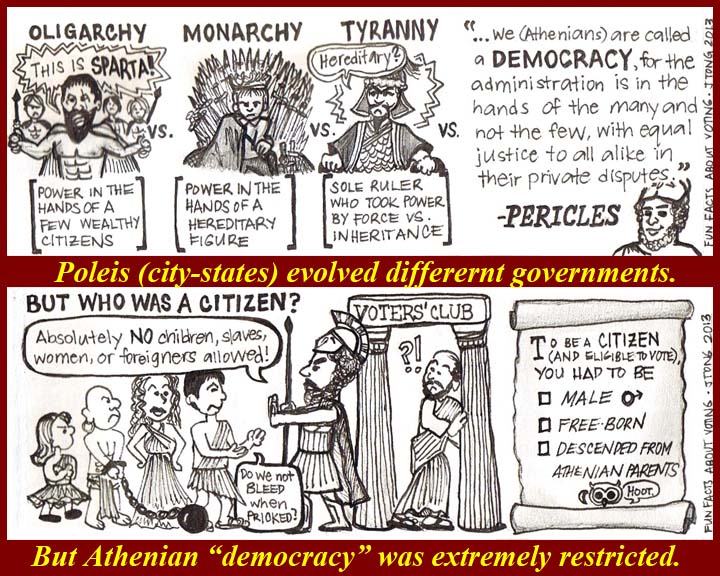
All of the possible forms of government available to the
Athenians were problematic. Much vaunted Athenian
democracy was extremely restricted; only male adults
both of whose parents were citizens could participate in
Athenian political life. (The cartoon is, in
fact, incorrect -- females with proper parentage
could be "citizens", but they were not allowed to
exercise their citizenship except by
producing more citizens.
Athenian democracy developed around the fifth century BC
in the Greek city-state (known as a polis) of Athens,
comprising the city of Athens and the surrounding
territory of Attica and is the first known democracy in
the world. Other Greek cities set up democracies, most
following the Athenian model, but none are as well
documented as Athens.
It was a system of direct democracy, in which
participating citizens voted directly on legislation and
executive bills. Participation was not open to all
residents: to vote one had to be an adult, male citizen,
and the number of these "varied between 30,000 and
50,000 out of a total population of around 250,000 to
300,000.
See https://en.wikipedia.org/wiki/Athenian_democracy.
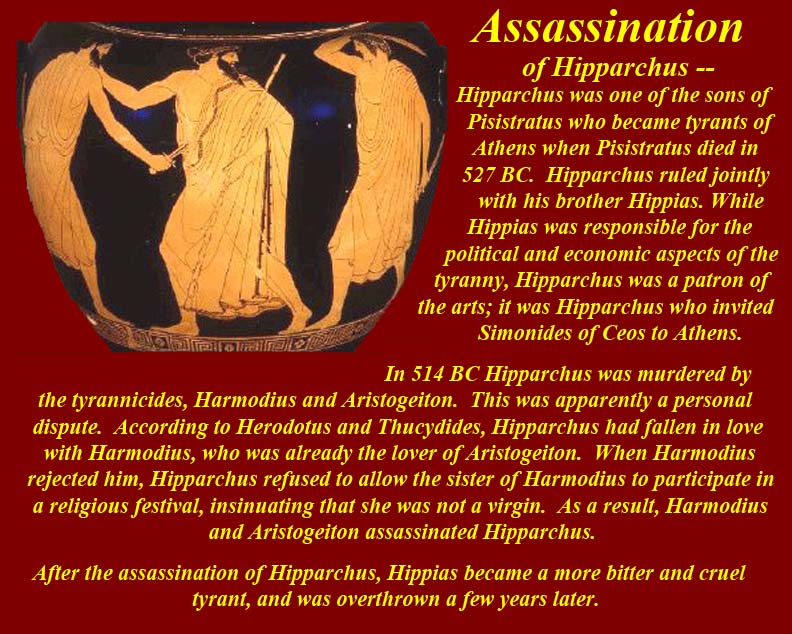
Peisistratos died in 527 or 528 BC. He was succeeded by
his eldest son, Hippias. Hippias and his brother,
Hipparchus, ruled the city much as their father
did. After a successful murder plot against
Hipparchus conceived by Harmodius and Aristogeiton,
Hippias became paranoid and oppressive. This
change caused the people of Athens to hold Hippias in
much lower regard. The Alcmaeonid family helped
depose the tyranny by bribing the Delphic oracle to tell
the Spartans to liberate Athens, which they did in 508
BC. The Peisistratids were not executed, but
rather were mostly forced into exile. Afterwards,
the surviving Peisistratid, Hippias went on to aid the
Persians with their attack on Marathon acting as a
guide.
See https://en.wikipedia.org/wiki/Peisistratos
and http://www.britannica.com/biography/Peisistratus.
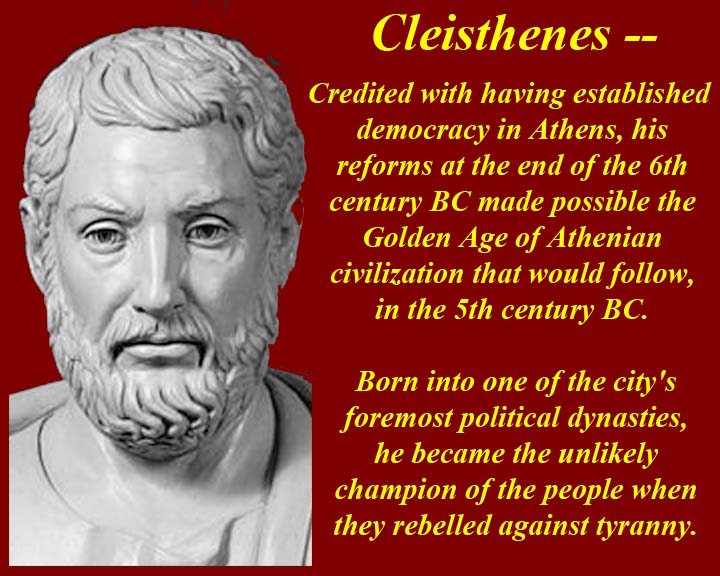
Cleisthenes of Athens, also spelled Clisthenes
(born c. 570 bce—died c. 508), statesman regarded as the
founder of Athenian democracy, serving as chief archon
(highest magistrate) of Athens (525–524).
Cleisthenes successfully allied himself with the popular
Assembly against the nobles (508) and imposed democratic
reform. Perhaps his most important innovation was
the basing of individual political responsibility on
citizenship of a place rather than on membership in a
clan.
See http://www.britannica.com/biography/Cleisthenes-of-Athens
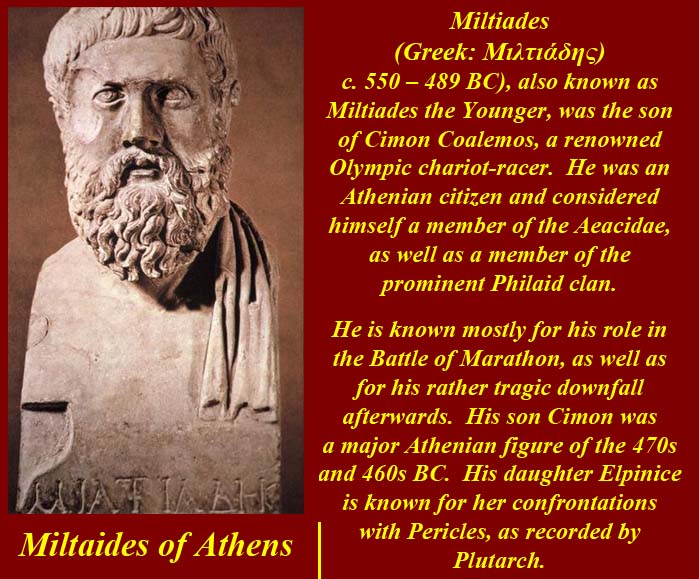
Miltiades was an Athenian who inherited the position of
tyrant a colony on the Thracian Chersonese (now the
Gallipoli Peninsula) where he ruled harshly. After the
collapse of the Ionian revolt against Persia (494 BC),
Miltiades and his clan fled back to Athens, taking
shiploads of wealth with them. The Athens to which
Miltiades returned was no longer a tyranny, it had
overthrown the Peisistratids and become a democracy 15
years earlier. Thus, Miltiades initially faced a hostile
reception for his tyrannical rule in the Thracian
Chersonese. Miltiades successfully presented
himself as a defender of Greek freedoms against Persian
despotism, and also promoted the fact that he had been a
first-hand witness to Persian tactics, a useful resume
considering the Persians were bent on destroying the
city, and so Miltiades escaped punishment and was
allowed to rejoin his old countrymen.
Miltiades is often credited with devising the tactics
that defeated the Persians in the Battle of
Marathon. Miltiades was elected to serve as one of
the ten generals (strategoi) for 490 BC. In
addition to the ten generals, there was one 'war-ruler'
(polemarch), Callimachus, who had been left with a
decision of great importance. The ten generals
were split, five to five, on whether to attack the
Persians at Marathon then, or later. Miltiades
was firm in insisting that the Persians be fought
immediately as a siege of Athens would have led to its
destruction, and convinced Callimachus to use his
decisive vote to support the necessity of a swift
attack.
He also convinced the generals of the necessity of not
using the customary tactics, as hoplites usually marched
in an evenly distributed phalanx of shields and spears,
a standard with no other instance of deviation until
Epaminondas. Miltiades feared the cavalry of the
Persians attacking the flanks, and asked for the flanks
to have more hoplites than the centre. Miltiades
had his men march to the end of the Persian archer range
then break out in a run straight at the Persian
army. This was very successful in defeating the
Persians, who then tried to sail around the Cape Sounion
and attack Attica from the west. Miltiades got his
men to quickly march to the western side of Attica
overnight, causing Darius to flee at the sight of the
soldiers who had just defeated him the previous evening.
The following year, 489 BC, Miltiades led an Athenian
expedition of seventy ships against the Greek-inhabited
islands that were deemed to have supported the Persians.
The expedition was not a success. His true
motivations were to attack Paros, feeling he had been
slighted by them in the past. The fleet attacked
the island, which had been conquered by the Persians,
but failed to take it. Miltiades suffered a
serious leg wound during the campaign and became
incapacitated.
His failure prompted an outcry on his return to Athens,
enabling his political rivals to exploit his fall from
grace. Charged with treason, he was sentenced to death,
but the sentence was converted to a fine of fifty
talents. He was sent to prison where he died, probably
of gangrene from his wound.
See https://en.wikipedia.org/wiki/Miltiades
and http://www.britannica.com/biography/Miltiades-the-Younger.
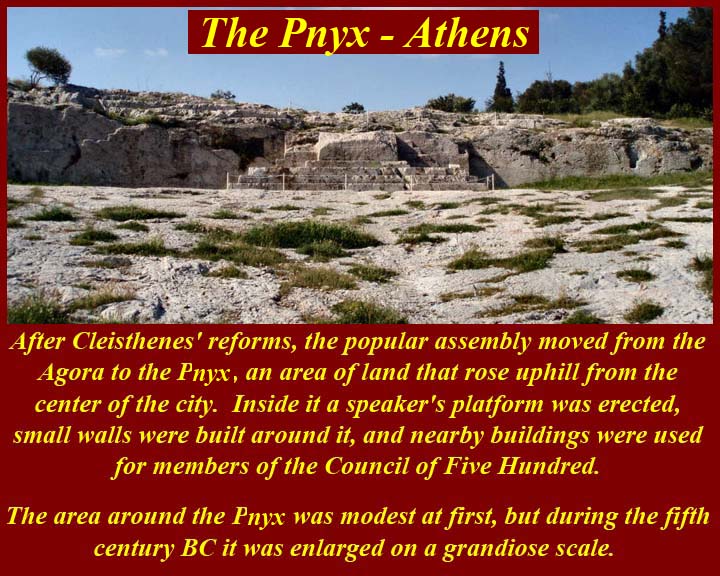
The pnyx was the rock platform in Athens where the
popular assembly convened. Any citizen could speak
at the assembly and voting was done by dropping white or
black pebbles int the ballot box.
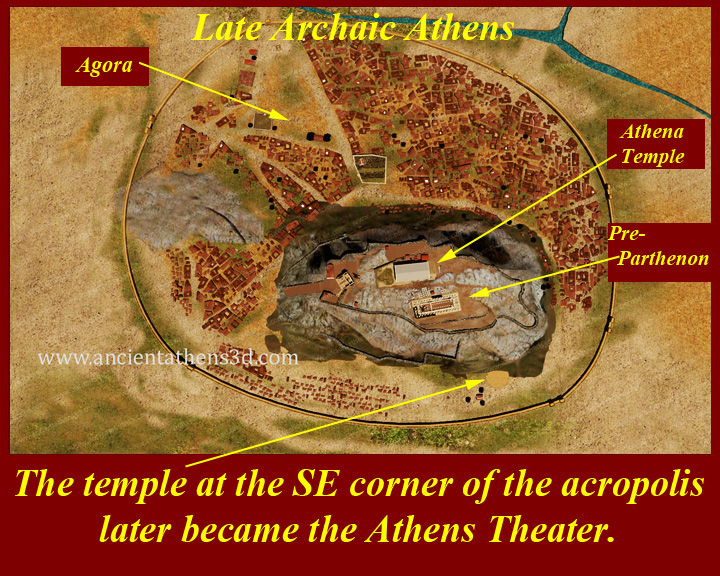
Major locations in Archaic Athens
Acropolis
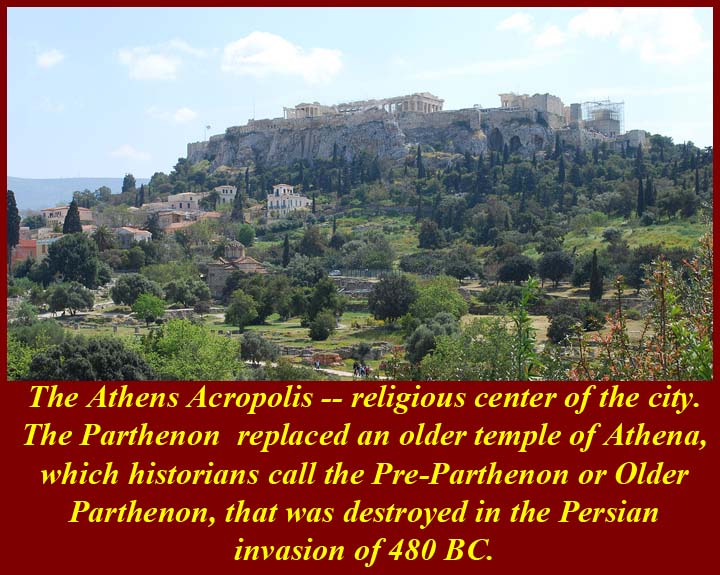
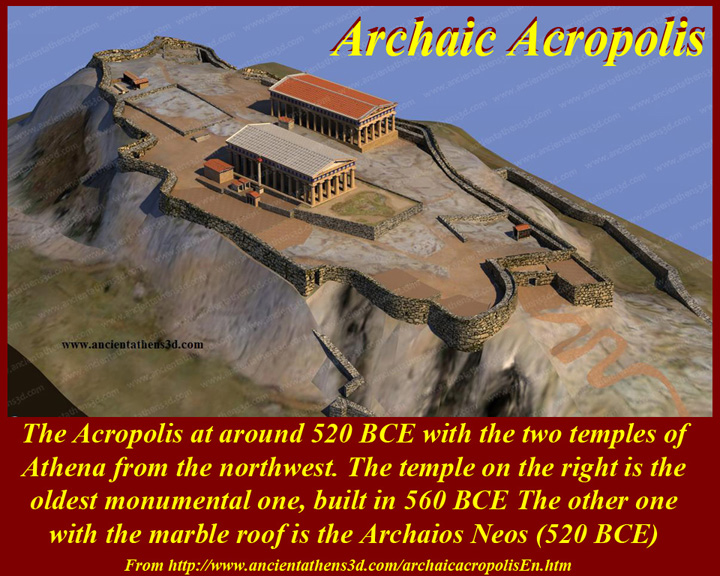
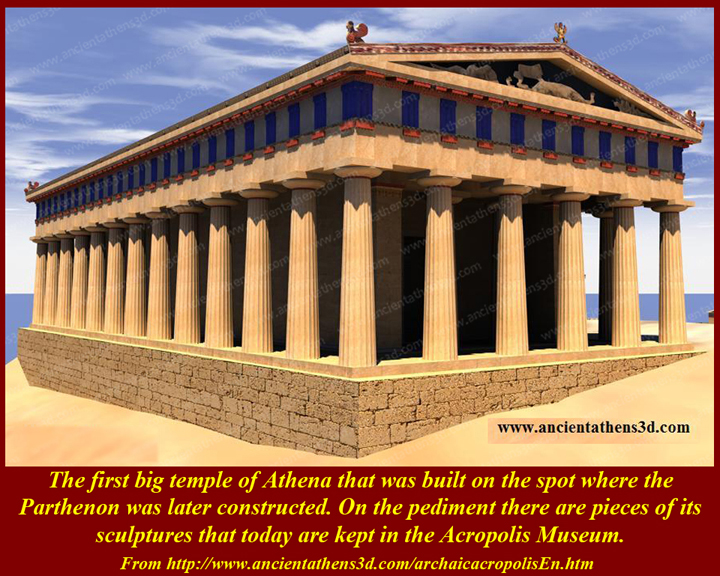
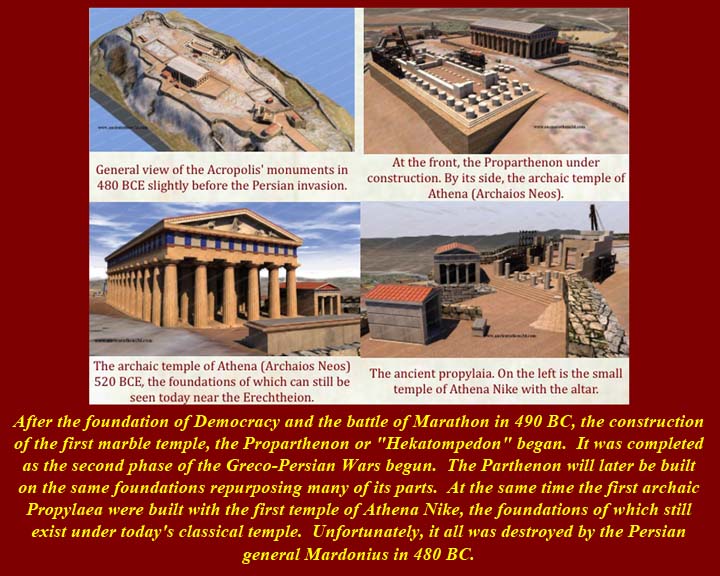
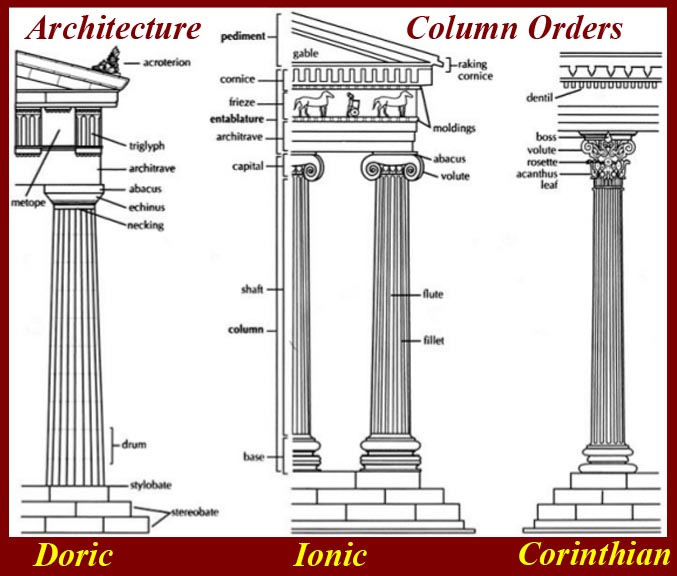
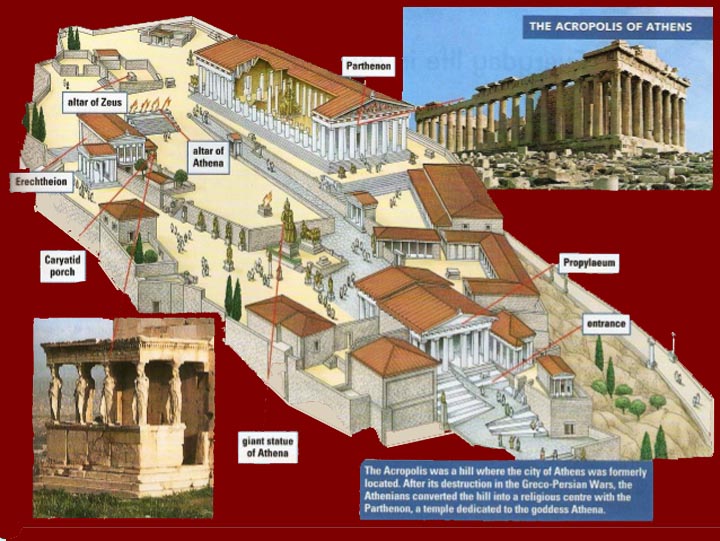
Read about the development of the Athens Acropolis at https://en.wikipedia.org/wiki/Acropolis_of_Athens.
For more images and more extensive explanations of the
Archaic Period Acropolis, see http://www.ancientathens3d.com/archaicacropolisEn.htm
and http://ancient-greece.org/history/acropolis.html.
Agora
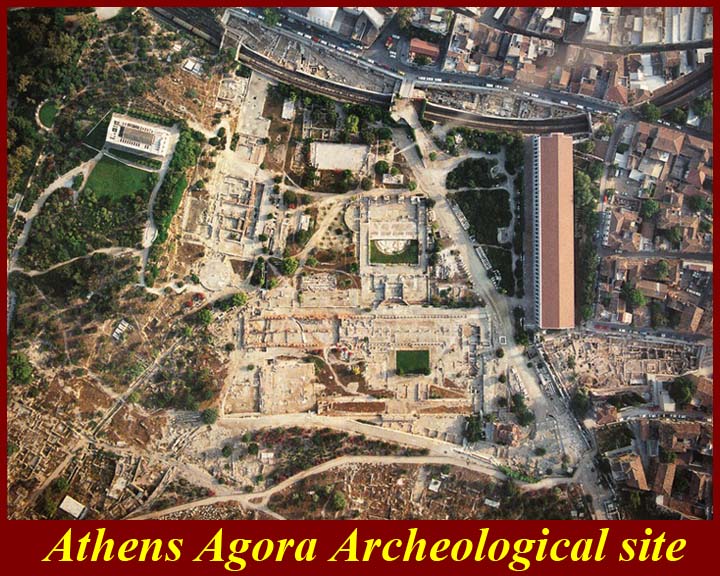
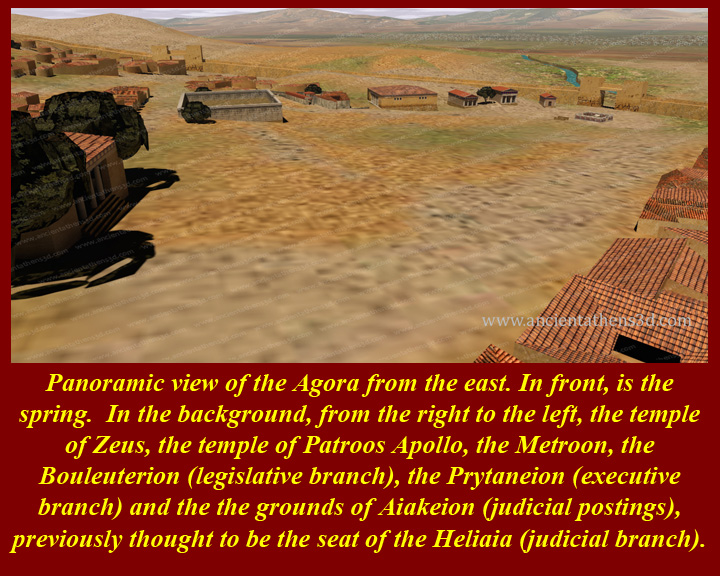
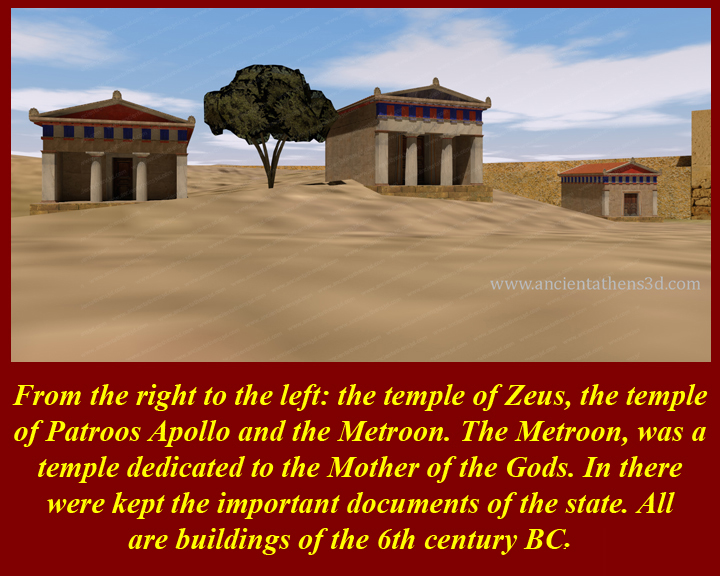
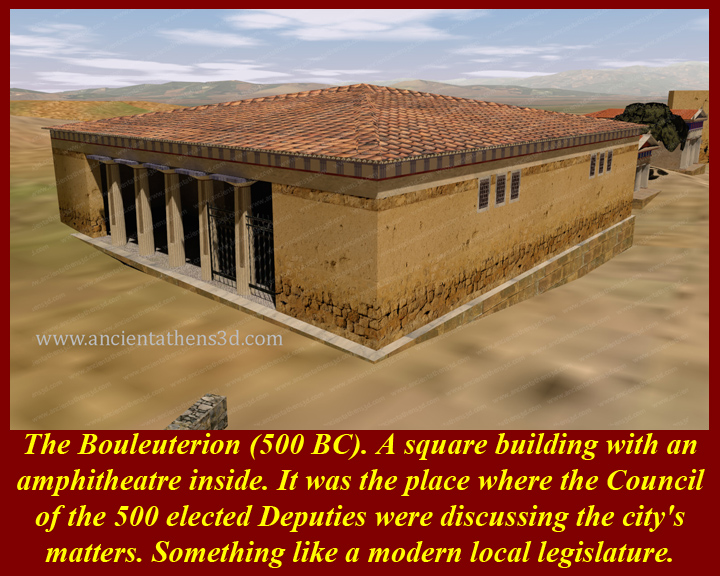
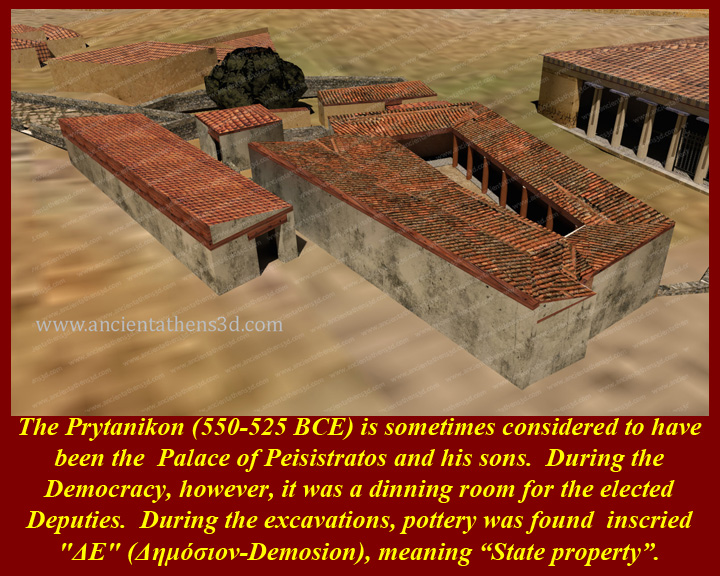
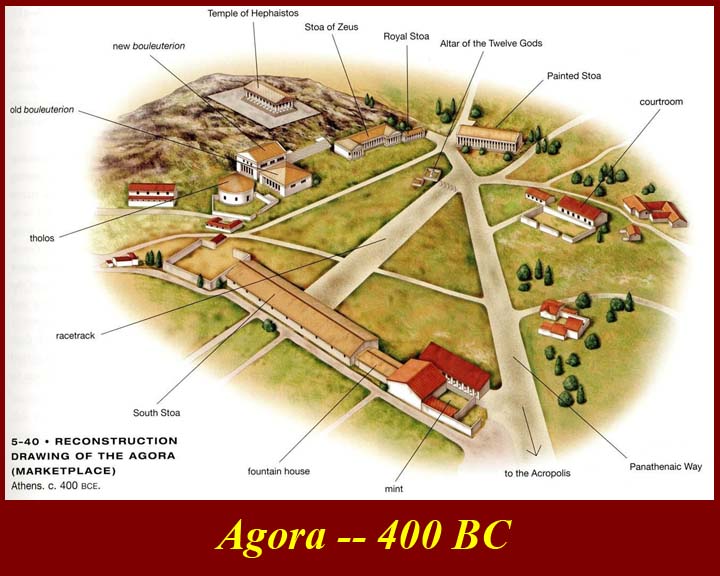
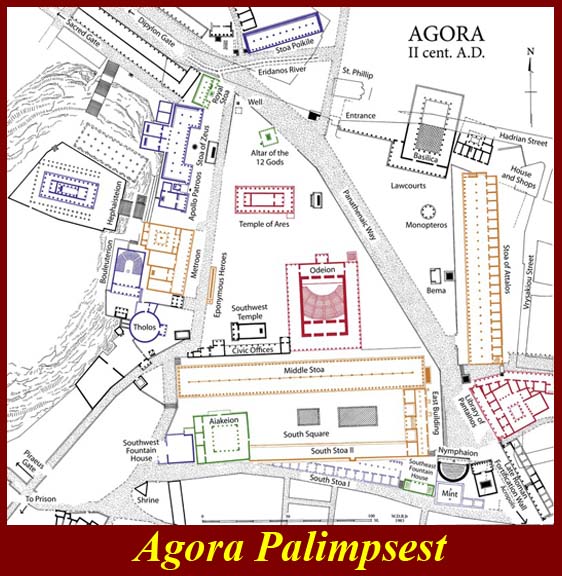
Read
about the development of the Athens Agora at http://www.ancient.eu/article/144/.
See also http://www.ancientathens3d.com/archaicagoraEn.htm
and http://ancient-greece.org/archaeology/agora.html
and http://ancient-greece.org/history/acropolis-archaic.html
And http://www.ascsa.edu.gr/index.php/excavationAgora.
AtticCulture -- Lyric (Metic) Poetry
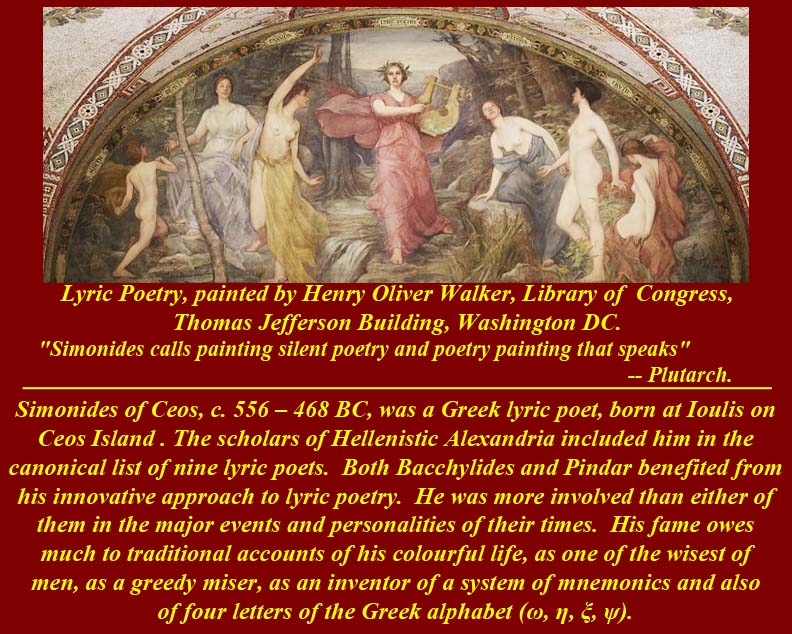

Simonides was an innovator among Archaic period Greek
lyric poets. A major member of the canonical "nine
lyric poets", he is considered to have been the
first to have composed poetry meant to be read rather
than received by listening. He also is credited
with having invented four letters in the revised Greek
alphabet (ω, η, ξ, ψ -- that is, omega, eta, ksi, and
psi) and with inventing a memory system ("memory
palace" or "method of loci"). He was born in
the Archaic period and lived into the Classical period
See https://en.wikipedia.org/wiki/Simonides_of_Ceos
and https://en.wikipedia.org/wiki/Nine_Lyric_Poets
and https://en.wikipedia.org/wiki/Palatine_Anthology
and https://en.wikipedia.org/wiki/Method_of_loci.
Symposia
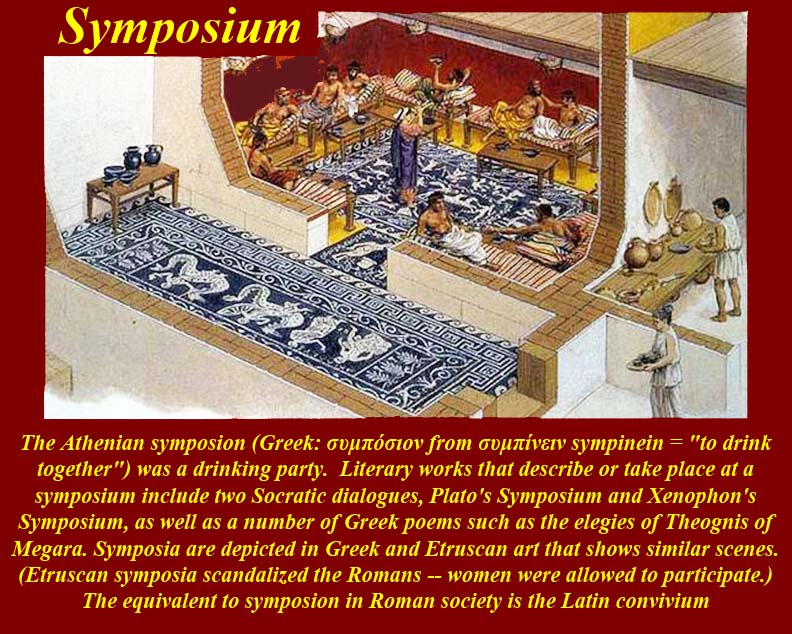
The Greek symposion (Latin convivium)
was a key Hellenic social institution. It was a
forum for men of respected families to debate, plot,
boast, or simply to revel with others. They were
frequently held to celebrate the introduction of young
men into aristocratic society. Symposia were also
held by aristocrats to celebrate other special
occasions, such as victories in athletic and poetic
contests. ...
Symposia were usually held in the andrōn
(ἀνδρών), the men's quarters of the household. The
participants, or "symposiasts", would recline on
pillowed couches arrayed against the three walls of the
room away from the door. Due to space limitations the
couches would number between seven and nine, limiting
the total number of participants to somewhere between
fourteen and twenty seven. ...
See https://en.wikipedia.org/wiki/Symposium
for a description of the Greek symposium
and, for Plato's Symposium in English, see http://classics.mit.edu/Plato/symposium.html.
Sparta
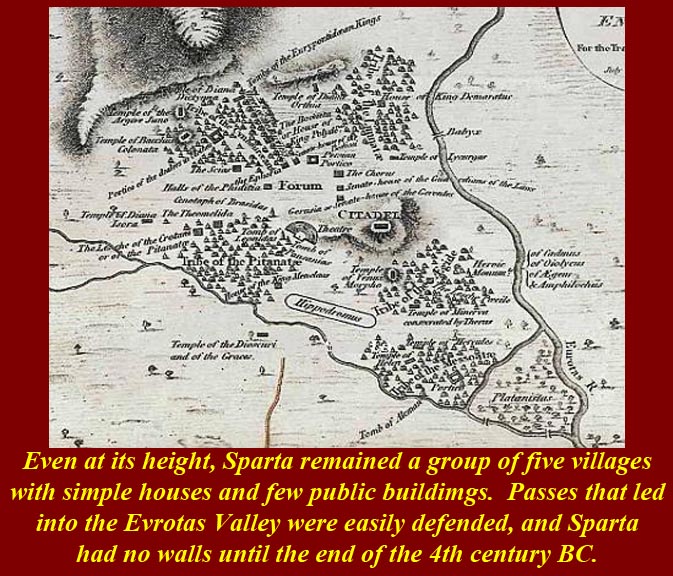
Unlike Athens, which had a previously existing citadel
and town, Sparta always was a collection of four (later
five) Dorian villages in the easily defendable Eurotas
River valley. The valley had been inhabited by
earlier groups from as early as the Middle Neolithic,
but was not considered to be "Spartan" until the Dorians
took over the area in the latter part of the Dark Age
period. (The Dorians were either new immigrants or
were a formerly subjugated majority that took over
during the Dark Age.)
Archeologically, Sparta itself begins to show signs of
settlement only around 1000 BC, some 200 years after the
collapse of Mycenaean civilization Of the four
villages that initially made up the Spartan Polis,
historian George
Forrest suggests that the two closest to the
Acropolis were the originals, and the two more far flung
settlements were of later foundation. The dual kingship
may originate in the fusion of the first two
villages. One of the effects of the Mycenaean
collapse had been a sharp drop in population.
Following that, there was a significant recovery, and
this growth in population is likely to have been more
marked in Sparta, as it was situated in the most fertile
part of the plain.
Between the 8th and 7th centuries BC the Spartans
experienced a period of lawlessness and civil strife,
later testified by both Herodotus and Thucydides.
As a result, they carried out a series of political and
social reforms of their own society which they later
attributed to a semi-mythical lawgiver, Lycurgus.
These reforms mark the beginning of the history
oClassical Sparta.
For more on the history and development of Sparta, see https://en.wikipedia.org/wiki/History_of_Sparta
and http://www.ancient.eu/sparta/
and http://www.civilization.org.uk/greece-2/sparta.
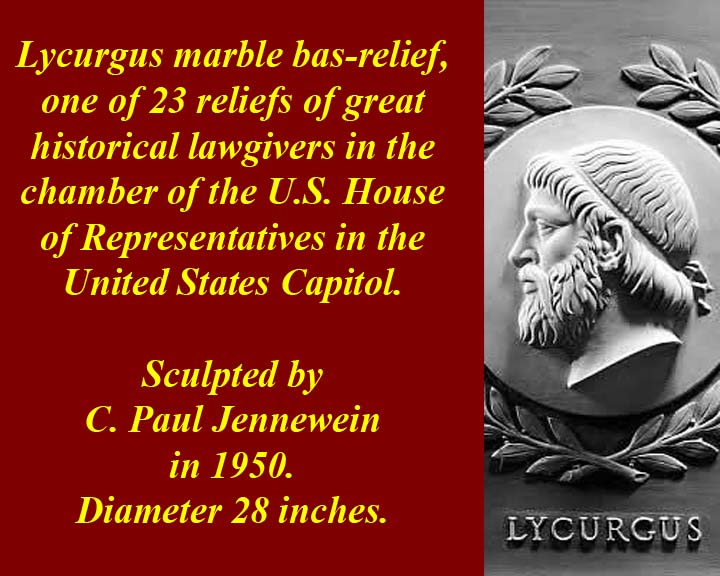
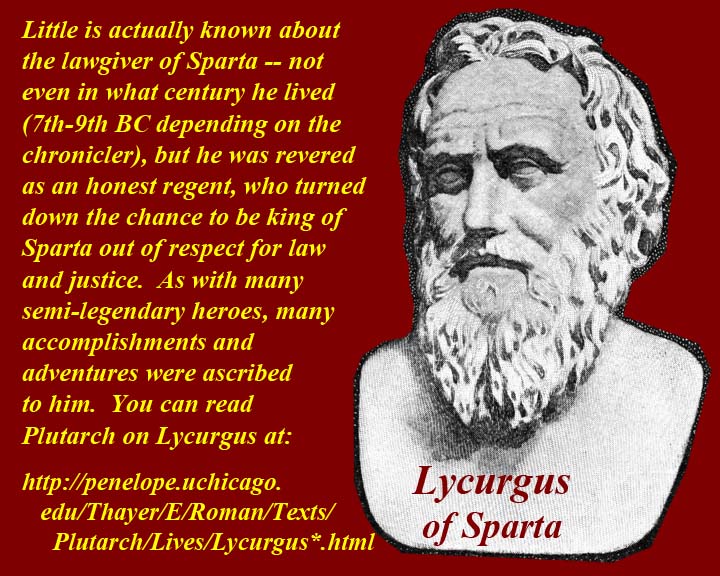
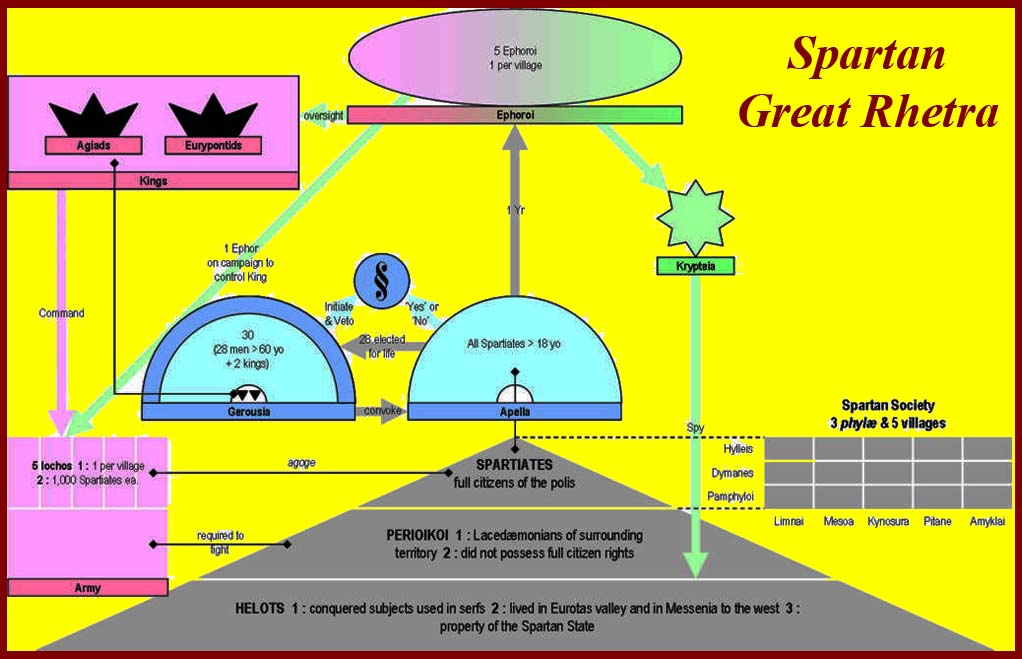
We don't know much about Lycurgus, even when or whether
he was alive or a real person. It's another
founding myth like the Theseus myth of the founding of
Athens. Spartans believed that he was their
organizer and lawgiver, a man who refused an offer of
kingship out of respect for law and justice.
The myth includes the story of how Lycurgus, seeing the
disorder in early Sparta, sought advice from the Delphic
Sybil and received in reply the "Great Rhetra" as a
complete constitution for Sparta. Once again there
are inconsistencies and anachronisms which are glossed
by Herodotus but are , in fact, acknowledged by
Plutarch.
See https://en.wikipedia.org/wiki/Lycurgus_of_Sparta
and http://www.mmdtkw.org/Gr0926SpartaGreatRhetra.jpg
and (Herodotus on Lycurgus) http://ancienthistory.about.com/library/bl/bl_text_herodotus_1.htm#65
and (Plutarch on Lycurgus -- lives) http://penelope.uchicago.edu/Thayer/E/Roman/Texts/Plutarch/Lives/Lycurgus*.html
and (Plutarch on Lycurgus -- Moralia, Apophthegmata
Laconica ) http://penelope.uchicago.edu/Thayer/E/Roman/Texts/Plutarch/Moralia/Sayings_of_Spartans*/Lycurgus.html
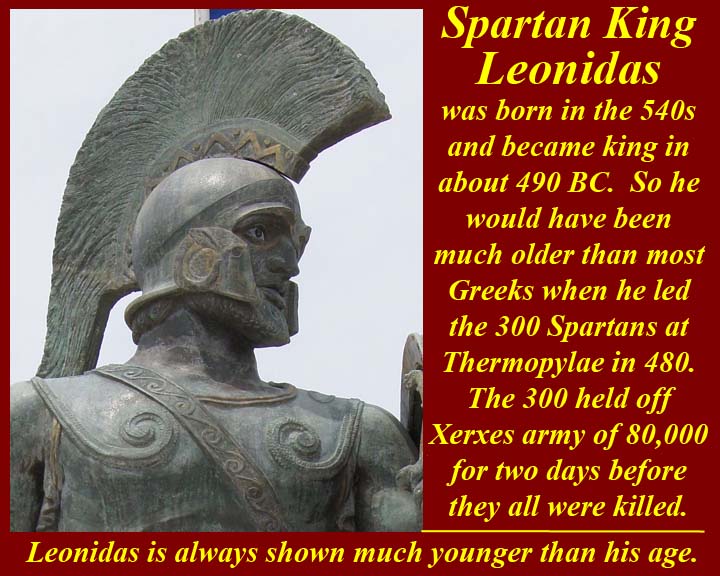
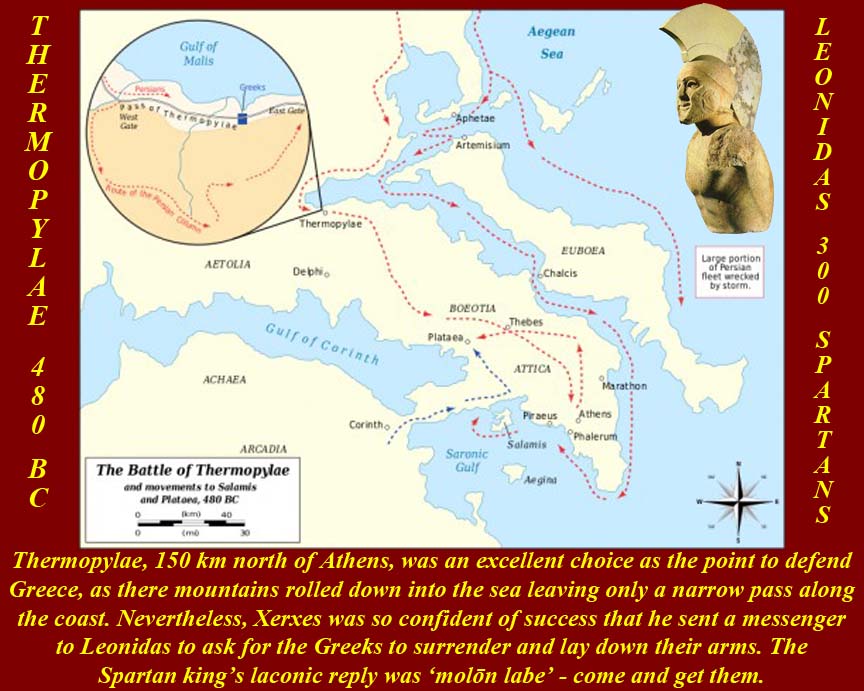
Leonidas
of Sparta was already an old man by ancient Greek
standards when he and three hundred Spartans held off
the 80,000 Persians under Xerxes at Thermopylae in 480
BC. (The Spartans could have been said to have
taught the Persians what the name of the place really
meant; "the hot gates of Hell"). The battle
delayed the Persians long enough to allow the Athenians
and their fleet to retreat to Salamis Island where the
destruction of the Persian fleet caused Xerxes to
retreat from Greece never to return. All of this
will be covered in the next unit (and see
https://en.wikipedia.org/wiki/Battle_of_Thermopylae
if you can't wait for next week.)
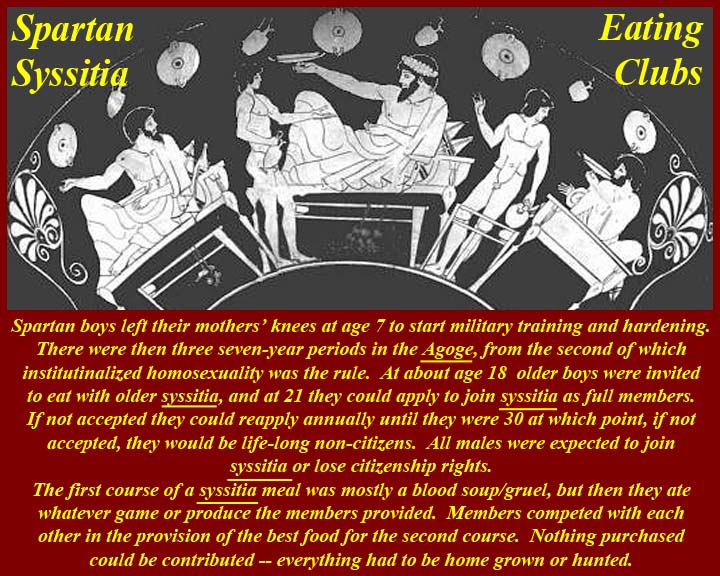
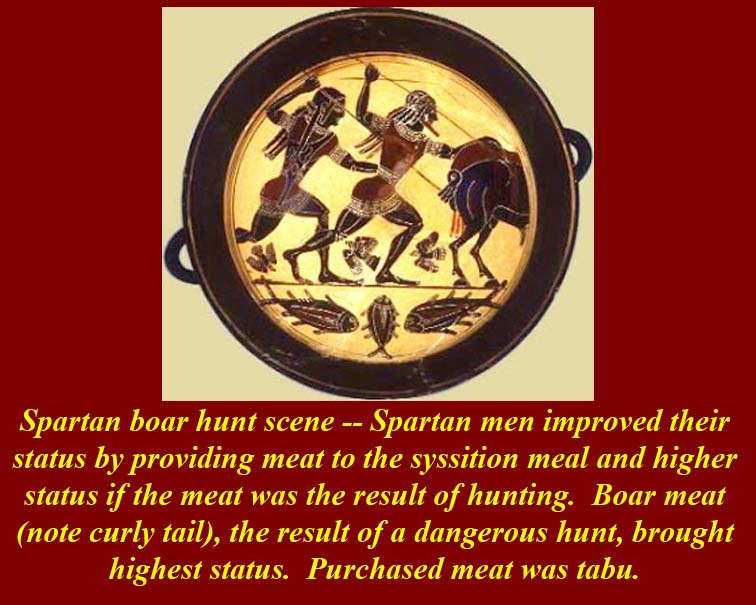
Syssition/Syssitia -- There is a
great deal of discussion of how the singular (syssition)
and plural (syssitia) forms of the word should be
used and whether they refer to the eating groups or to
the meals the groups ate together. Even the
ancient Greeks apparently couldn't decide.
Whichever form is used, this is what happened; Syssition/Syssitia was/were
the culmination of the coming-of-age process
called agoge.
The agōgē (Greek: ἀγωγή in Attic Greek, or
ἀγωγά, agōgá in Doric Greek) was the rigorous
education and training regimen mandated for all
male Spartan citizens, except for the firstborn
son in the ruling houses, Eurypontid and Agiad.
The training involved learning stealth,
cultivating loyalty to the Spartan group,
military training (e.g. pain tolerance),
hunting, dancing, singing and social
(communicating) preparation.[1] The word "agoge"
meant in ancient Greek, rearing, but in this
context generally meant leading, guidance or
training.[2]
According to folklore, agoge was introduced by
the semi-mythical Spartan law-giver Lycurgus but
its origins are thought to be between the 7th
and 6th centuries BC[3][4] when the state
trained male citizens from the ages of seven to
twenty-one.[1][5]
The aim of the system was to produce physically
and morally strong males to serve in the Spartan
army. It encouraged conformity and the
importance of the Spartan state over one's
personal interest and generated the future
elites of Sparta. The men would become the
"walls of Sparta" because Sparta was the only
Greek city with no defensive walls after they
had been demolished at the order of Lycurgus.
Discipline was strict and the males were
encouraged to fight amongst themselves to
determine the strongest member of the group.
From about age 14, boys were taken into
homosexual pairing with older males.
At age 21 a young man who had completed agoge
would apply to join a syssitiongroup of adult
males who would eat all their evening meals
together and sleep in their barracks.
More information is available at the Internet
sites listed immediately below.
For more on Syssitia, see https://en.wikipedia.org/wiki/Syssitia
For the Syssytia diet, see http://thespartandiet.blogspot.com/2010/10/inside-spartan-syssition.html
For Agoge, see https://en.wikipedia.org/wiki/Agoge
For Spartan maturity processes, see:
(Male) http://www.labrys.gr/index-en.php?l=catalysing_maturity-en#8
and (Female) http://www.labrys.gr/index-en.php?l=catalysing_maturity-en#11.
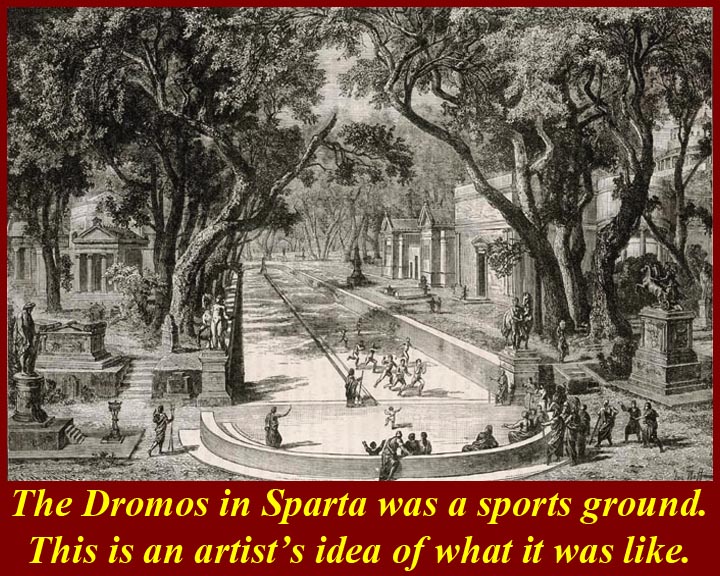
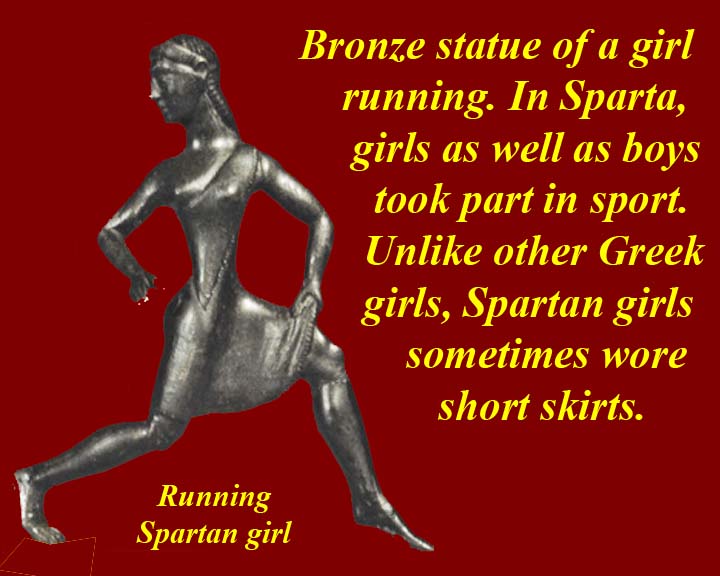
Training and competition in running were integral
parts of the upbringing of all Spartans, male and
female. Everyone was expected to be completely
physically fit with the males ready for battle and
females ready for child bearing (as soon a they were
physically mature -- starting in their early their
teen years.)
See http://www.sikyon.com/sparta/agogi_eg.html
and https://legacy.fordham.edu/halsall/ancient/xeno-sparta1.asp
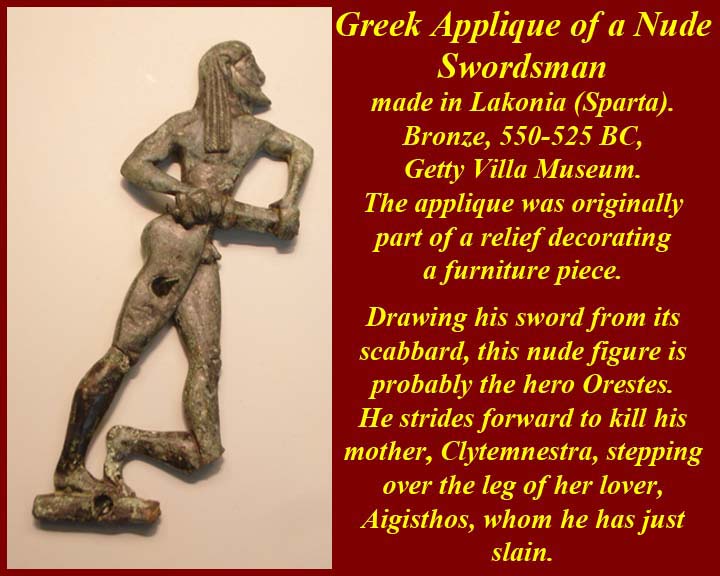 Bronze
furniture relief
Bronze
furniture relief 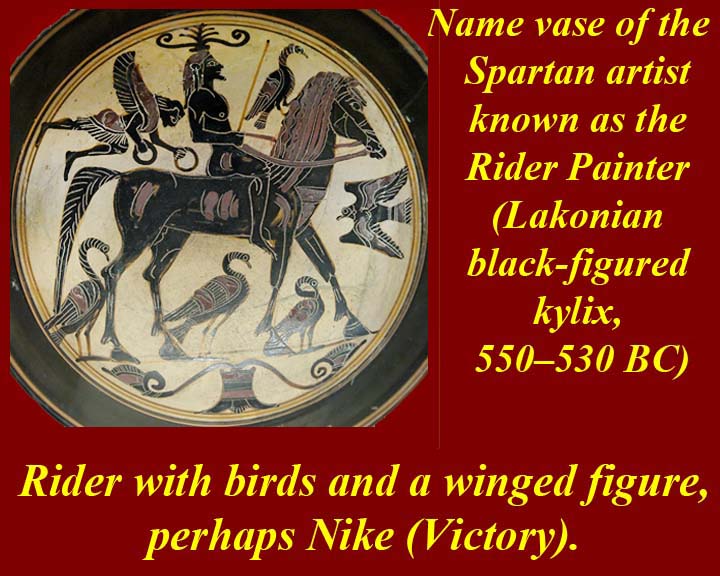 Painted horseman kylix (drinking bowl)
Painted horseman kylix (drinking bowl)
Spartan detailed bronze artwork is
characteristically on a martial or training pattern as
is the figure from the bottom of a kylix showing a
victorious horseman.
See http://www.metmuseum.org/toah/hd/spar/hd_spar.htm
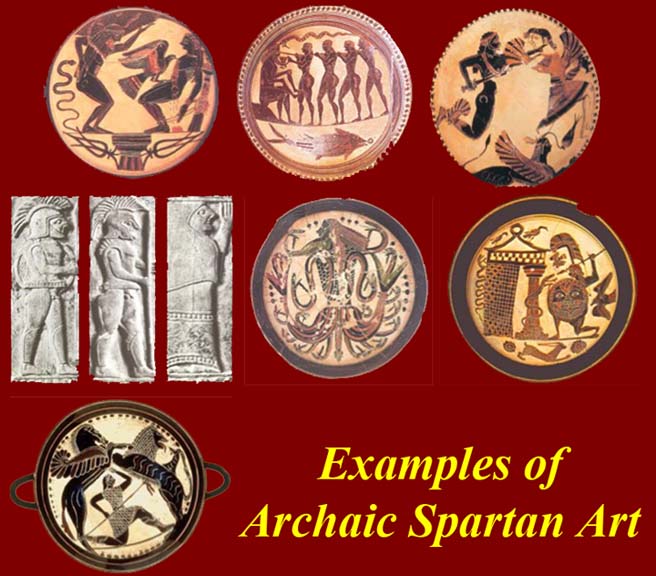
There is a great deal of controversy surrounding the question of why Greek communities became poleis. Some historians and political analysts found it inevitable. Aristotle, in fact, claimed that the polis was the natural situation for mankind. He defined humans as "beings who by nature live in a polis" (Politics 1253a2-3). However, the polis was a unique Greek invention and far from inevitable. The specific geography and history of Greece allowed its conception.





















Bronze furniture relief
Painted horseman kylix (drinking bowl)





















